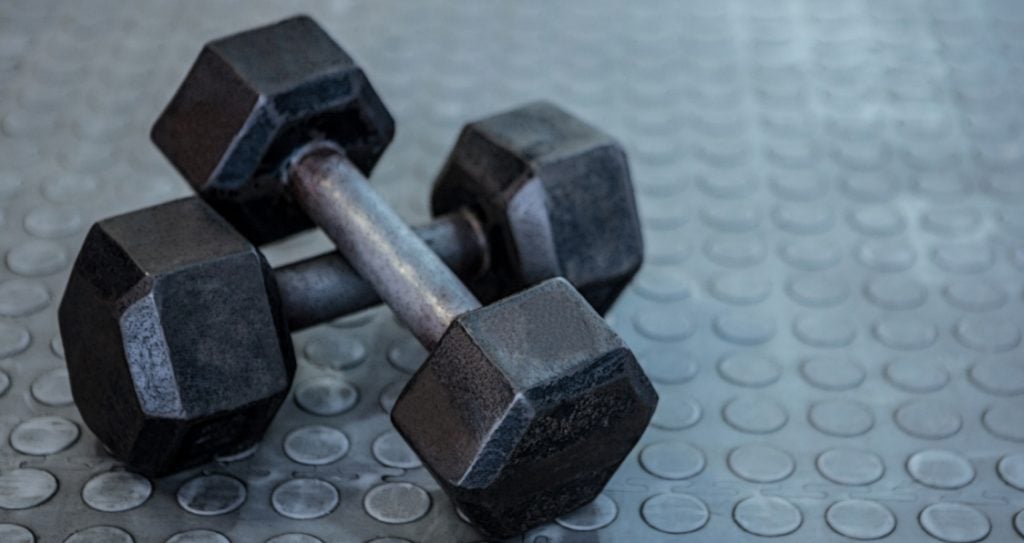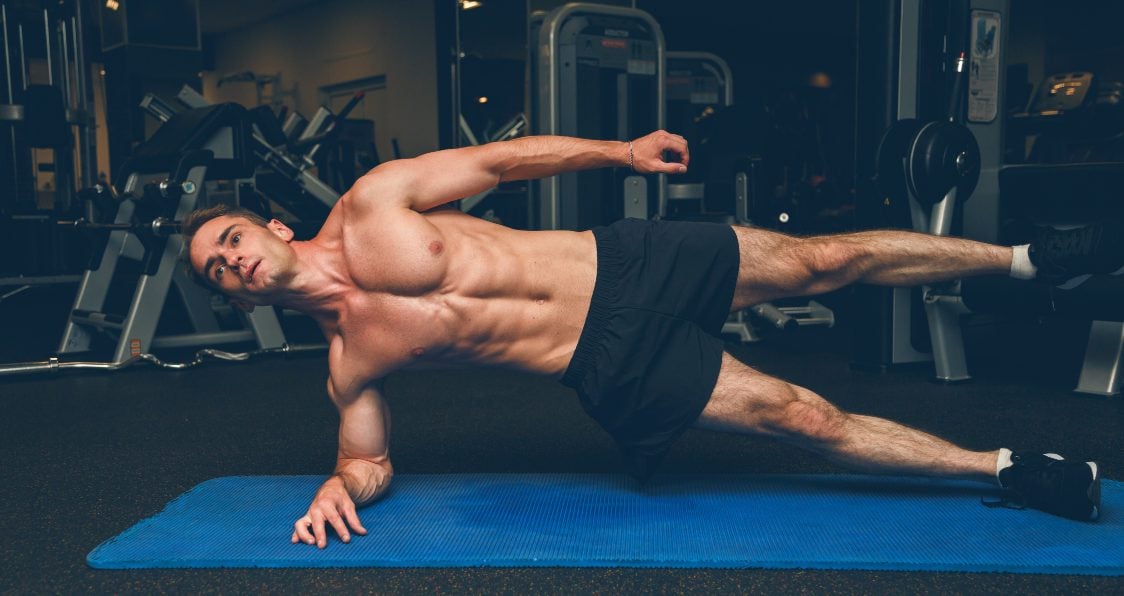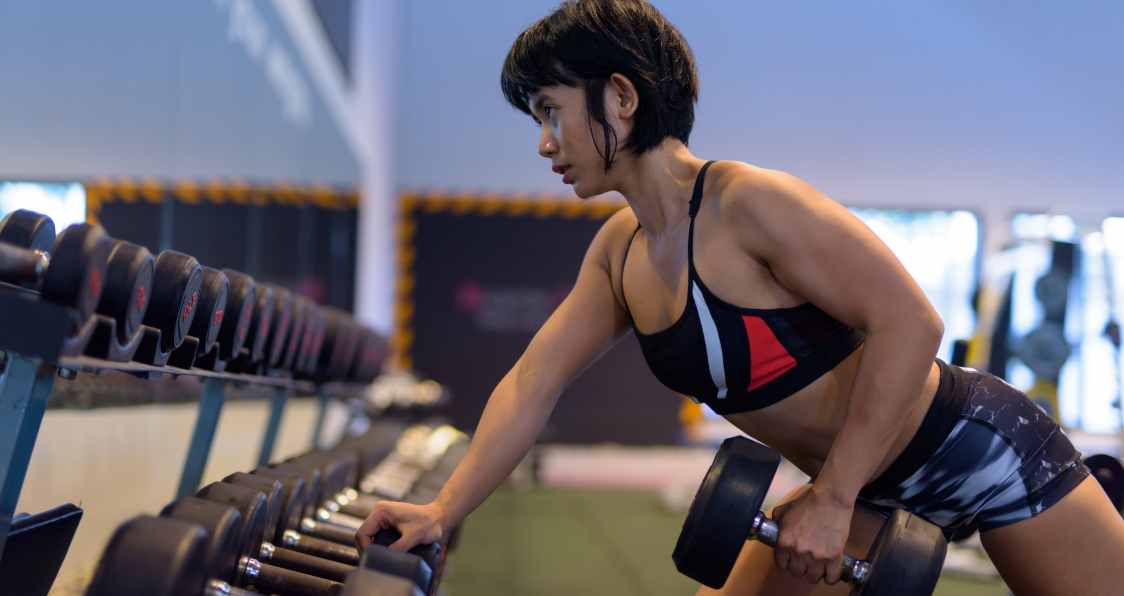Unconventional Core Training for Effective Strength Gains
When it comes to selecting core development exercises, there are a number of popular exercises that are often chosen – crunches, side bends, Russian twists & planks.
There is no denying that these exercises are highly effective when performed correctly. However, after some time it may become necessary to find alternative core exercises.
It may be necessary to change them as a method of progressive overload or because there is a need to freshen up your training to maintain motivation or adherence.
Whatever the reason for performing new abdominal exercises, the dumbbell row side plank can present a real challenge, not just for the abdominals, but for the entire body.
Dumbbell Row Side Plank Technique & Muscles Worked
In terms of the muscles recruited in the exercise, there are many muscles must engage either to cause movement or stabilize the body.
The muscles which are primarily involved in the dumbbell row side plank are the abdominals, obliques, lats, rhomboids, adductors, and glutes.
There are a number of secondary muscles that assist in the exercise including the quads, hamstrings, traps, deltoids, and triceps.
Judging by the number of muscles listed, it should be evident that the dumbbell row side plank is a full-body exercise.
1) The Side Plank Position
When setting up for the dumbbell row side plank, it is imperative that the body is set in the right position before the rowing phase of the exercise can take place.
When assuming the side plank position, start on your side. Place your hand flat on the floor, and extend the arm fully ensuring that the hand is directly under the shoulder.
Keeping the core muscles engaged, lift the hips off the floor while extending the legs fully so that the body is held in a straight line – ankles, knees, hips, and shoulders should be aligned.
2) Locking the Shoulder
Prior to picking up the dumbbell, it’s important to ensure that the shoulder of the rowing arm is “locked” in position. To effectively do this, retract the shoulder and pull it downwards.
Allowing the shoulder to rise upward or pull forward will not only negatively impact the movement mechanics but may also place excessive strain on the shoulder joint thus increasing the risk of injury.
In addition, look to keep the supporting arm straight throughout the duration of the exercise. Allowing the elbow to bend may compromise stability and affect the side plank position.
3) Rip the Dumbbell
To allow you to reach the dumbbell on the floor it will be necessary to rotate the trunk slightly. Keep the chest up and core tight while you rotate in order to maintain alignment and protect the spine.
Once you pick up the dumbbell, rotate the trunk and simultaneously row the dumbbell powerfully into the body and maximally squeeze between the shoulder blades.
In the row, ensure that the elbow is kept slightly down from the height of the shoulder as the dumbbell is pulled into the body. Allowing the elbow to rise up can place strain on the shoulder joint.
4) Control the Descent
As you begin to lower the dumbbell back down to the floor, avoid dropping the dumbbell too quickly as this will only increase the risk of pulling the body out of position.
Instead, squeeze the abdominals, reverse the rowing action in a controlled manner and slowly rotate through the trunk in order to bring the dumbbell back down.
Lowering the dumbbell in a controlled fashion while maintaining core engagement will effectively facilitate a solid side plank position thus reducing the risk of sustaining of injury.
Dumbbell Row Side Plank Benefits
The dumbbell row side plank can prove to be a highly effective exercise for a range of lifters and athletes. This section will expand on a select number of benefits associated with the dumbbell row side plank.
1) Enhanced Full-Body Stability
As mentioned, the dumbbell row side plank places a large demand on the core. Often the function of the core is misunderstood – the core works to stabilize the body as it moves (1).
The core maximally engages during the side plank in order to hold the body in the correct position. The addition of the dumbbell row places even more demand on the core to work and maintain stability.
Furthermore, proprioceptive abilities such as balance and coordination will also improve with regular practice thus enhancing full-body stability further.
2) Improved Ab Strength & Definition
The abdominals are often mistaken to be just one muscle; however, there are four individual muscles that make up the abdominal muscle group – the transverse abdominis, rectus abdominis, internal oblique & external oblique (2).
All four of these muscles must isometrically contract in the side plank to successfully hold the side plank. The obliques must also concentrically and eccentrically contract to cause the trunk to rotate in the row.
Regularly performing the dumbbell row side plank will place a large demand on the abdominal muscles and cause them to increase in both size and strength.
3) Improved Pulling Strength
The lats are wing-like muscles found in the back that are predominantly responsible for all upper body pulling exercises.
The row phase of the exercise will place great stress on the lats, as well as a number of other back muscles (3), consequently causing a significant adaptation in back strength and size.
Having bigger and stronger lats, rhomboids, traps, and rear delts will improve your pulling capacity and build your back.
4) Performance Facilitation
Finally, a combination of the aforementioned benefits associated with the dumbbell row side plank can have a positive impact on athletic performance and injury risk.
Having a stronger and more stable core can notably impact compound lifts such as the squat, deadlift, presses, and Olympic lifts, and may facilitate a safer, more effective lift.
Increasing the strength of the back and your pulling capacity may also transfer into a greater performance with all upper body pulling exercises such as the lat pulldown and row.
Dumbbell Row Side Plank Variations & Alternatives
This section will highlight a number of variations that can be utilized to advance the dumbbell row side plank and add demand to maintain a steady rate of adaptation.
There are also three dumbbell row side plank alternatives listed that will allow you to regress the exercise if necessary.
Variations
Alternating Dumbbell Row Side Planks
The alternating version involves switching sides after each rep. On completion of a row on one side, immediately move into a side plank on the alternate side and complete a row.
Continuously switch from side to side until you have completed the prescribed number of reps.
Constantly switching arms will not only add a challenge in terms of stability and coordination, but it will also place an increased demand through the shoulders.
Eccentric Dumbbell Row Side Planks
For the eccentric variation, complete the movement as normal, however, look to slowly the dumbbell back down to the floor with each and every rep.
Using a descent of 3-5 seconds will add mechanical tension and increase the degree muscular damage sustained – both of which are principles of muscular growth (4).
As a result, eccentric exercises can be considered an effective method for bringing about calisthenics workout.
Archers Row Side Planks
The archers row variation starts in a full plank position rather than the side plank. Grip the dumbbell and as you begin to row, simultaneously rotate the body into a side plank.
From that position, keep the core tight and gradually reverse the movement by extending the arm and rotating the trunk until you assume the full plank position once again. Switch sides and repeat for the designated number of reps.
Alternatives
Dumbbell Fly Side Planks
The dumbbell fly side plank is very similar to the original exercise and it works the body in a similar fashion.
The only difference between the two exercises is that a fly in performed rather than a row. For the fly, maintain a straight arm and drive the dumbbell up until it is directly over the shoulder joint.
The fly will place more of a stress on the rear delts (back of the shoulder) and typically a lighter weight will be used for this variation.
Renegade Rows
The renegade row is exactly the same as the dumbbell row side plank however, it places the body in a full plank rather than a side plank.
For the renegade row, start in a full plank position while holding onto two dumbbells. Row one dumbbell into the body while maintaining a full plank, control the descent and then swap sides and repeat.
Plank Pull Through
For the plank pull through, assume a full plank position and place a weight to the right side of the body.
Keeping the core tight, lift the left hand from the floor, reach under the body, grab the weight side and pull it through. Alternate hands and repeat.
Final Word
It is clear that the dumbbell row side plank is an effective developer of abdominal strength, core stability, and pulling power, all of which contribute towards improving athletic performance.
As a result, all lifters and athletes should seriously consider incorporating this exercise into their training regime.
References:
1 – Kibler, W. Ben; Press, Joel; Sciascia, Aaron (2006). “The role of core stability in athletic function”. Sports Medicine (Auckland, N.Z.). 36 (3): 189–198. doi:10.2165/00007256-200636030-00001. ISSN 0112-1642. PMID 16526831.
2 – Services, Department of Health & Human. “Abdominal muscles”. www.betterhealth.vic.gov.au.
3 – Fenwick, Chad M. J.; Brown, Stephen H. M.; McGill, Stuart M. (2009-03). “Comparison of different rowing exercises: trunk muscle activation and lumbar spine motion, load, and stiffness”. Journal of Strength and Conditioning Research. 23 (2): 350–358. doi:10.1519/JSC.0b013e3181942019. ISSN 1533-4287. PMID 19197209.
4 – Franchi, Martino V.; Reeves, Neil D.; Narici, Marco V. (July 4, 2017). “Skeletal Muscle Remodeling in Response to Eccentric vs. Concentric Loading: Morphological, Molecular, and Metabolic Adaptations”. Frontiers in Physiology. 8. doi:10.3389/fphys.2017.00447. ISSN 1664-042X. PMC 5495834. PMID 28725197.












